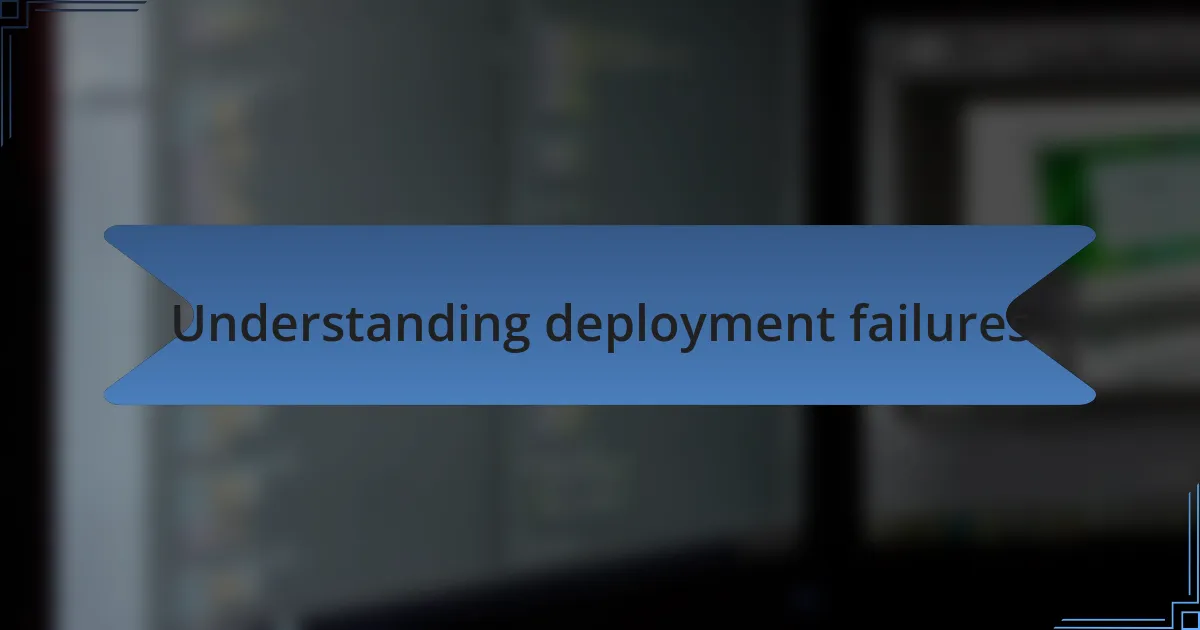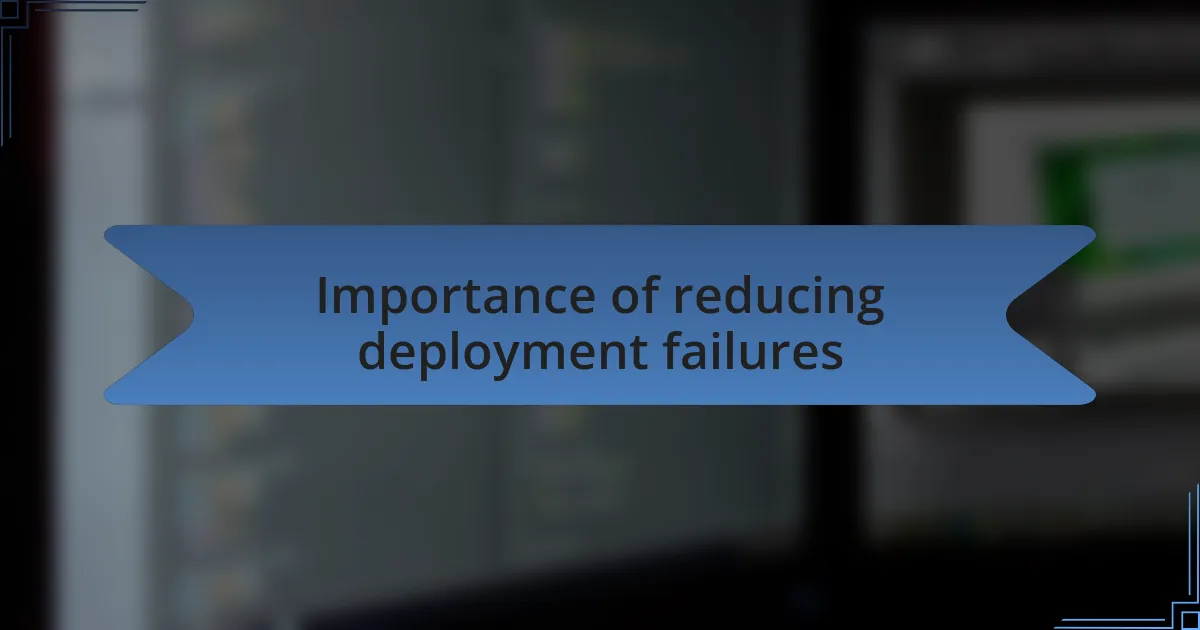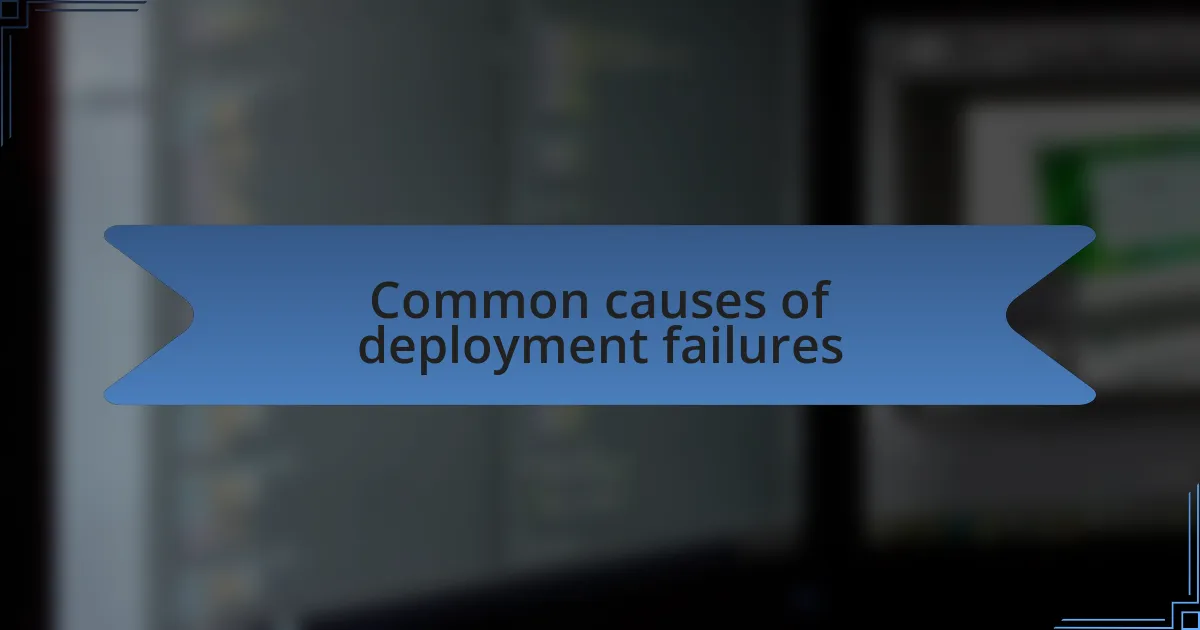Key takeaways:
- Deployment failures often arise from unexpected interactions between system components, overlooked dependencies, and configuration mismatches.
- Reducing deployment failures is essential for maintaining team morale, customer satisfaction, and minimizing financial losses.
- Implementing automation, rollback plans, and fostering communication can significantly reduce the risk of deployment failures.
- Utilizing CI/CD tools, monitoring solutions, and collaboration tools enhances deployment success and team coordination.

Understanding deployment failures
Deployment failures can be incredibly frustrating, especially when you’ve poured hours into preparing for a release. I remember a time when a simple bug led to a long downtime, and it made me realize just how critical it is to understand the underlying issues that can cause these failures. Have you ever felt that sinking feeling when you hit the deploy button, only to watch everything come crashing down?
At the core, deployment failures often stem from unexpected interactions between different components of the system. I once faced a situation where different team members were working on features that, when combined, produced unforeseen conflicts. It’s a sobering reminder that collaboration requires not just teamwork but also a clear understanding of each part’s role in the bigger picture.
Moreover, external factors such as network issues or server overload can also play a significant role. I learned this the hard way when a sudden spike in traffic during a deployment caused our site to fail spectacularly. It left me wondering: how can we better prepare for the unpredictability of real-world scenarios? Understanding these potential pitfalls can make a world of difference in reducing the chances of failure.

Importance of reducing deployment failures
Reducing deployment failures is essential for maintaining team morale and company reputation. I recall a particularly grueling release cycle that pushed my team to the brink. Each failure felt like a punch to our collective confidence, and the frustration was palpable. When deployments fail, it not only halts progress but also creates an atmosphere of doubt that can linger long after the issue is resolved. How do we rebuild that trust once it’s been shaken?
Furthermore, minimizing these failures directly impacts customer satisfaction. I once received a barrage of complaints after a botched deployment, and it hurt seeing our users frustrated with our product. Delivering a seamless experience is not just about getting the code right; it’s about instilling confidence in the end-users. When they encounter fewer issues, they’re more likely to engage and advocate for our product. Isn’t that the ultimate goal?
Additionally, every failure comes with a cost—whether it’s lost revenue, increased support tickets, or wasted resources. During one project, I calculated that each failed deployment we faced accounted for significant downtime and associated financial losses. Recognizing this connection has led me to approach deployment with a more cautious and methodical mindset. Shouldn’t every team strive to create a more efficient and failure-proof deployment process?

Common causes of deployment failures
One common cause of deployment failures that I’ve encountered is overlooked dependencies. During a past project, I vividly remember how a single library update broke our entire deployment. It was as if I’d overlooked the most critical piece of the puzzle, and the panic that ensued felt overwhelming. Have you ever faced a situation where something so small had such a massive impact? I learned that a rigorous dependency check is non-negotiable when preparing for deployment.
Another frequent culprit is unexpected configuration mismatches between environments. I once deployed to production only to discover that a configuration setting that worked perfectly in staging didn’t quite translate. The feeling of disbelief washed over me as I resolved issue after issue, wishing I had double-checked these details earlier. Isn’t it unsettling how easily such discrepancies can slip through the cracks, affecting the entire deployment?
Finally, inadequate testing can lead to disastrous results. There was a time I was too eager to push a feature, convinced of its flawless execution, only to have it crash during peak user traffic. The embarrassment was palpable, compounded by knowing that I hadn’t given it the thorough testing it deserved. This experience made me realize that a robust testing strategy isn’t just a formality; it’s a safety net that protects the integrity of deployments. How many times have we brushed testing aside, only to regret it later?

Strategies to minimize deployment failures
One effective strategy I’ve found essential is automating the deployment process. In my early days, I manually deployed updates, and I often felt a surge of anxiety each time, fearing a simple mistake would lead to chaos. When I finally embraced automation, it was like a weight lifted off my shoulders. Not only did it reduce errors, but it also granted me the freedom to focus on more impactful aspects of development.
Implementing a comprehensive rollback plan is another crucial strategy. There was a project where everything seemed perfect until a last-minute change shattered our confidence. I can still feel the knot in my stomach as we scrambled to integrate a fix while users were already experiencing issues. Having a rollback plan would have empowered us to revert to a previous stable version, minimizing downtime and user frustration. Have you ever wished for a safety net during a deployment?
Finally, fostering a culture of communication among team members can be transformative. In one of my projects, I made it a point to have daily stand-ups before a major release. It was incredible to see how discussing potential challenges and sharing insights helped us spot problems early, preventing them from snowballing into serious deployment failures. Have you ever noticed how sometimes just talking things through can illuminate solutions you hadn’t considered?

Tools for deployment success
Adopting the right tools can significantly enhance deployment success. For instance, I introduced CI/CD tools like Jenkins in my workflow, and it was a game-changer. Automating the build and deployment pipeline helped catch errors earlier, which drastically reduced the number of failed deployments. Have you ever felt the rush of relief when a deployment goes smoothly after implementing a new tool?
Monitoring tools are another aspect I can’t stress enough. In previous projects, I didn’t always monitor deployments post-launch, thinking everything would be fine. One time, a subtle bug went unnoticed for days, wreaking havoc on user experience. Now, I rely heavily on monitoring solutions like New Relic to keep tabs on application performance and catch issues in real-time. It’s that peace of mind knowing I’m ready to respond swiftly if something goes awry.
Collaboration tools also play a vital role. I remember struggling with version control during team projects, which often led to confusion and miscommunication. Once we integrated tools like Git and Slack, everything changed. Pull requests became clearer, and team discussions more seamless, ultimately driving successful deployments. How do you ensure collaboration among your team during deployments?

Personal experience and lessons learned
Throughout my journey, I’ve learned that preparation is just as crucial as execution. I recall one challenging deployment where I underestimated the impact of a minor database migration. It felt like I was holding my breath during the launch, and when things went wrong, the frustration was palpable. Since then, I’ve prioritized thorough pre-deployment reviews and established a checklist that ensures I don’t overlook any critical steps, helping to instill confidence in my team and myself.
Another lesson emerged from my experience with user feedback. Early on, I would deploy features based on assumptions, only to realize that users didn’t find them helpful. Once, a much-anticipated update fell flat, leaving me feeling disheartened. I now incorporate user testing before launch to align development with user needs. Isn’t it fascinating how tapping into real users can transform a product from simply functional to truly valuable?
Lastly, I’ve embraced the iterative process. Previously, I thought a deployment had to be perfect on the first try. After launching a flawed feature, I learned that feedback loops are crucial. I now welcome iteration; if something doesn’t resonate, we adjust and redeploy. This mindset shift not only eases the pressure but also leads to more innovative solutions. Have you ever realized that some of the best improvements come from learning and adapting?